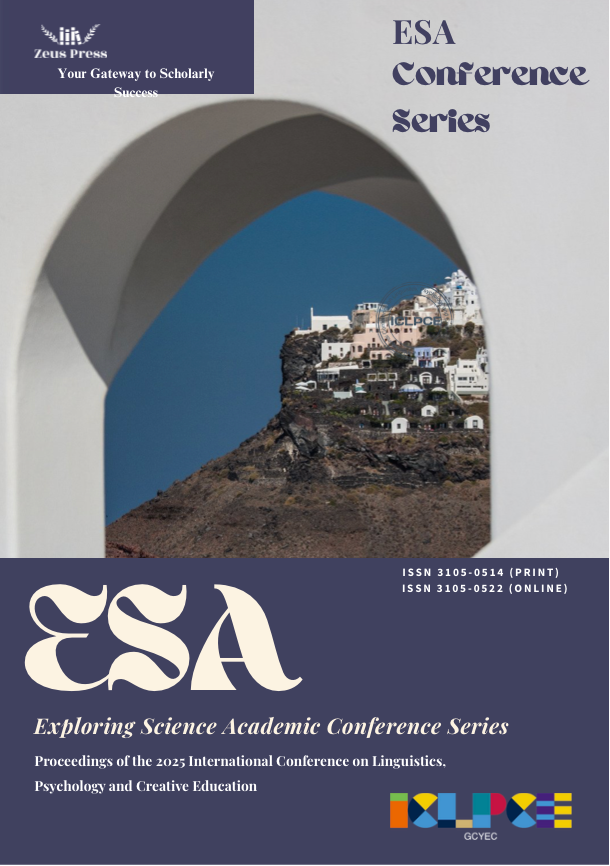Exploring the Predictive Factors and Sources in English Reading Anxiety from Individual Differences, Grammar Perspectives and Vocabulary Perspectives for Chinese Undergraduates
Main Article Content
Keywords
English reading anxiety, individual differences, grammar, vocabulary
Abstract
Anxiety is a negative emotion that may influence reading performance. The purpose of this study was to investigate the predictive effects of individual differences on Chinese undergraduate students' English reading anxiety and differences in grammar and vocabulary. The predictive effects of gender, major category, grade level, and current level of English proficiency were explored at the individual level. Word comprehension anxiety, word pronunciation anxiety and grammar anxiety are three sources of English reading anxiety. A total of 247 questionnaires were collected in this study, of which 207 were valid. A quantitative methodology was used in this research to handle the data. A multiple linear regression model was used to investigate these predictive factors, and it was found that gender, major category, and grade had no significant effect on Chinese college students' English reading anxiety, whereas the current level of English proficiency had a significant and uneven effect on English reading anxiety. For anxiety resources, Pearson correlation was used to explore the relationships between total reading anxiety scores and word comprehension anxiety, word pronunciation anxiety, and grammar anxiety to identify their ranks. The results of the study revealed that word comprehension anxiety was the most dominant of the three sources of anxiety, followed by grammar anxiety and word pronunciation anxiety. This study also discusses the reasons for these findings and provides pedagogical suggestions for teachers on how to tailor their teaching to the needs of their students, choose appropriate textbooks, and balance the weighting of grammar and vocabulary in English reading, which has a positive effect on the field of foreign language emotion research.
References
- Al-Obaydi, L. H., Rahul, D. and Pikhart, M. (2024). The effect of online oral reading on reading comprehension, reading anxiety, and classroom anxiety among EFL learners. Education and Information Technologies, vol. 29, no. 3, pp. 2841-2855.
- Chen, S., Du, H., Wang, S. and Yang, L. (2022). Understanding EFL reading anxiety in relation to learning motivation, attitudes and strategies for Chinese and Spanish undergraduates. System, vol. 108, p. 102842.
- Dewaele, J.-M. and MacIntyre, P. D. (2014). The two faces of Janus? Anxiety and enjoyment in the foreign language classroom. Studies in second language learning and teaching, vol. 4, no. 2, pp. 237-274.
- Hamada, A. and Takaki, S. (2022). Psychometric assessment of individual differences in second language reading anxiety for identifying struggling students in classrooms. Frontiers in Psychology, vol. 13, p. 938719.
- Horwitz, E. K., Horwitz, M. B. and Cope, J. (1986). Foreign language classroom anxiety. The Modern language journal, vol. 70, no. 2, pp. 125-132.
- Hsiao, T.-Y. (2002). Unidimensionality of the Chinese version of the foreign language reading anxiety scale. Perceptual and Motor Skills, vol. 95, no. 3, pp. 927-933.
- Karamina, W., Astrid, A. and Amrina, R. D. (2024). Factors affecting students’anxiety in reading comprehension of high school students in palembang. Language and Education Journal, vol. 9, no. 1, pp. 52-73.
- Li, L., Yu, Q., Guan, Q., Li, H. and Luo, Y.-j. (2024). Attention allocation in foreign language reading anxiety during lexical processing− An ERP study with cue-target paradigm. Brain and Cognition, vol. 182, p. 106225.
- Miao, Q. Q. and Vibulphol, J. (2021). English as a Foreign Language Reading Anxiety of Chinese University Students. International Education Studies, vol. 14, no. 3, pp. 64-71.
- Saito, Y., Garza, T. J. and Horwitz, E. K. (1999). Foreign language reading anxiety. The modern language journal, vol. 83, no. 2, pp. 202-218.
- Schnotz, W. and Kürschner, C. (2007). A reconsideration of cognitive load theory. Educational psychology review, vol. 19, no. 4, pp. 469-508.
- Sweller, J. (2017). Cognitive load theory and teaching English as a second language to adult learners. Contact Magazine, vol. 43, no. 1, pp. 10-14.
- Tran, T. T. T. (2012). A Review of Horwitz, Horwitz and Cope's Theory of Foreign Language Anxiety and the Challenges to the Theory. English Language Teaching, vol. 5, no. 1, pp. 69-75.
- Ying, L. (2022). A study of college students' English reading anxiety, strategies and performance correlation. Journal of Taiyuan City Vocational and Technical College, no. 2, pp. 155-157.
- Zemni, B. and Alrefaee, Y. (2020). Investigating the Source of Reading Anxiety among Undergraduate Saudi Female EFL Students in Translation Departments. TESOL International Journal, vol. 15, no. 5, pp. 65-77.
- Zheng, S. (2024). The effects of chatbot use on foreign language reading anxiety and reading performance among Chinese secondary school students. Computers and Education: Artificial Intelligence, vol. 7, p. 100271.


